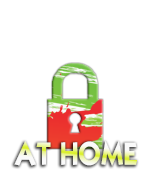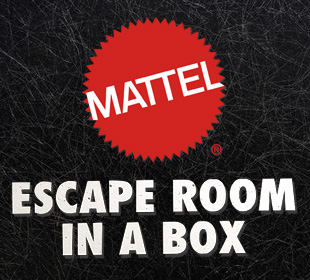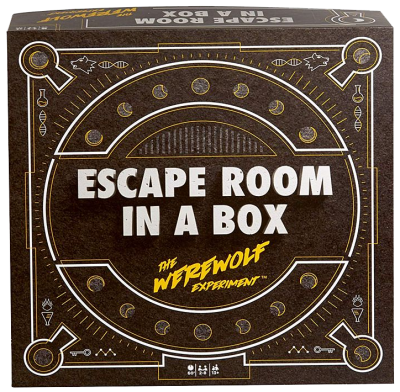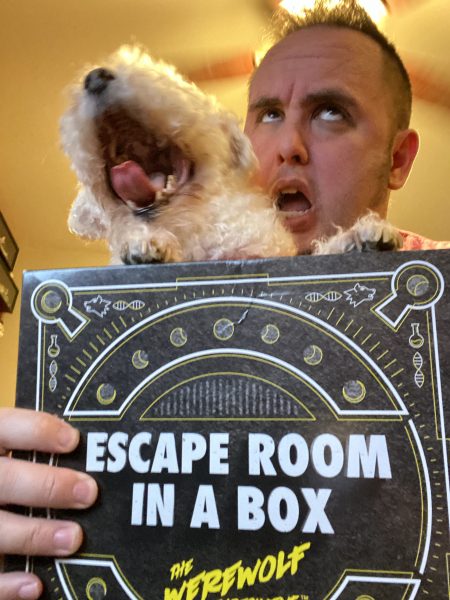RATING: 1 Key RESULT: Win REMAINING: 0:54
A professionally produced home game, released by one of the world’s leading toy companies? What could possibly go wrong?
But after playing it, we’re begging you to not waste that silver bullet on the werewolf; Please aim at us instead.

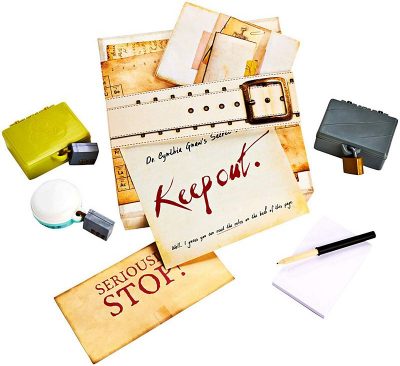 “FROM THE DESK OF DR. CYNTHIA GNAW
“FROM THE DESK OF DR. CYNTHIA GNAW
As your former colleague, I feel it is my duty to share this exiting breakthrough with you. I must warn you, though, it comes with a price. Intrigued? You should be. This is unlike anything you’ve ever experienced before. Open the box and find out for yourself.”
A mad scientist is plotting to turn you and your friends into werewolves. Only if you and your team members can solve 19 2D and 3D puzzles in an hour will you be able to escape with your humanness intact!
Not-so-famous, not-so-scientist Dr. Cynthia Gnaw has been working on a werewolf antidote, and to prove it, she’s ready to turn all of her colleagues into werewolves as well, because escape game. Luckily, it doesn’t take a science-type brain to know the way to cure a werewolf is actually quite simple: solve a handful of generic puzzle book tasks in under an hour! Also something about a full moon, probably.
The Werewolf Experiment absolutely does its best to begin in a storyworld – albeit poorly structured. It’s difficult to take “a scientific genius” seriously when they use terms like “super awesome,” “crazy smart” and “whoopsie” in their field notes. To make a story immersive, its characters have to be written in such a way that the audience can suspend disbelief and accept that they are real. We were left feeling as though Dr. Gnaw was either a teenage girl on Instagram, or scripted by one.
And that’s not even touching on the name in the first place. Your werewolf’s name is Dr. Gnaw? Maybe that’s why she became a werewolf in the first place?
Joking aside, The Werewolf Experiment begins with at least some small semblance of story, before quickly turning ‘generic escape room’ without ever looking back. And sadly, it’s not even close to a good generic escape room.

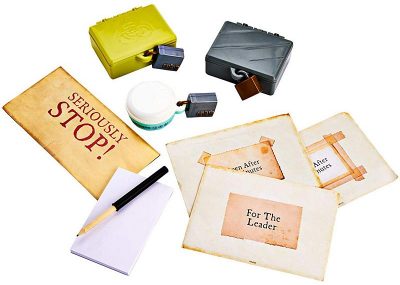 As we’ve touched on previously, being a home game, we define “Scenic,” from a graphic design perspective, as well as the quality, weight and feel of print materials inside the box.
As we’ve touched on previously, being a home game, we define “Scenic,” from a graphic design perspective, as well as the quality, weight and feel of print materials inside the box.
Inside Escape Room in a Box, there’s a lot of content. Three separate envelopes, each full of multiple sheets of paper, a few small science-themed physical components (like a petri dish and syringe) three small locked boxes and a keychain-sized blacklight flashlight, as well as a pencil and notepad to document progress. And while Mattel packs the most “authentic-style physical content” into this home game, all of it feels cheaply made.
The boxes and locks are cast from flimsy plastic – so much so that they actually feel like they could fall apart if you turn the dials on them one too many times, something in itself that proves to be a challenging feat given the wheels rarely stay put as you’re setting a code. The printed materials have the sense of being screened on low-grade copy paper. In fact, one of them actually tore multiple times when we simply – and gently – tried to erase something we’d very lightly written in pencil. Even the blacklight – which in concept seems like a surprising thing to actually include within the box, is such junk that it barely illuminates anything, making using it much more frustrating than need be.
Unlike many other home games, Escape Room In A Box has no companion app of any sort – meaning The Werewolf Experiment has no themed background music, sound effects, ambiance, or official game time. (The instructions suggest you use your phone’s stopwatch.)

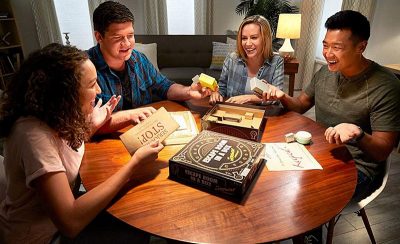 Imagine almost every cliché style of puzzle you dread finding in a brick and mortar escape game. The kind of puzzles that make you roll your eyes. The kind of puzzles that make you instantly look around your group in desperate hopes of finding some poor sucker to pass it off to. Now imagine a game where every puzzle is one of those. Are you willing to just give up and turn into a werewolf yet?
Imagine almost every cliché style of puzzle you dread finding in a brick and mortar escape game. The kind of puzzles that make you roll your eyes. The kind of puzzles that make you instantly look around your group in desperate hopes of finding some poor sucker to pass it off to. Now imagine a game where every puzzle is one of those. Are you willing to just give up and turn into a werewolf yet?
Escape Room in a Box has, perhaps, the worst collection of puzzles we’ve ever encountered in a home game. That’s not to say they’re all illogical (although some of them are) – but simply put, there wasn’t one single puzzle within the course of this game – this game which boasts its 19 puzzles – that we actually wanted to work on.
Every step along the way – and we do mean every single step – was the kind of tedious time-wasting puzzle that escape game fans have come to dread – a crossword puzzle, a word search, connect the dots, spot the difference between two images. We’re talking puzzlebook type stuff that one may pull out when they have time to kill a cross-country flight.
And these aren’t the only escape game faux pas to be found within The Werewolf Experiment. Included along the way are a handful or riddles, some of which you may either know the answer to or not (and no, they are in no way connected to the theme.) One puzzle, involving completing phrases and idioms verges dangerously close to something requiring prior knowledge. A paper folding-type task completes complete with convoluted instructions, making it so that if you did not already know how to fold one of these from your days as a teenage girl, you could be faced with some serious frustration. This game also has an instance where a previously used object is required to be used again – something often frowned upon in the escape game world. There’s even some objects hidden outside of the game itself, in places like the retail packaging or under cardboard dividers within the box. Not only does this present an illogical and irrational expectation that players are to connect, but it instantly kills what little storyworld The Werewolf Experiment has managed to build up to that point, breaking the fourth wall for, well, absolutely no reason or benefit what so ever.
Perhaps worst of all, one multi-step puzzle full of time-sink style tasks does nothing more than lead you to a hidden object freely available to be found at any point in time. Should you find that object just through common-sense sleuthing – as we did, and as we’d imagine many other experienced players will, what will come from completing that puzzle track is confusion at best, and at worst, unbridled frustration upon reaching the realization that the last several tiresome tasks served no purpose.

Escape Room in a Box came to us highly recommended early on – and sadly we’ve come to realize after playing it that this advice is based not on the quality of the product or the ingenuity of its puzzles, but the fact that it was “designed” by self-proclaimed “escape game enthusiasts” – just like you or I. It’s surprising that a game created by enthusiasts could include so very many of the the puzzles enthusiasts dread finding inside a brick and mortar escape room. But just like a brick and mortar game should never be rated based on how friendly its owners are, here too, we must base our assessment solely on the quality of the experience contained within its cardboard walls.
While we appreciate Mattel attempting to add the authenticity of “real” locks to open, their obscenely lower quality production value did little here to increase market share. Escape Room in a Box quickly became one of our least favorite home games, by a large margin. While other lesser quality home games have left us frustrated by puzzle flow logic leaps, at least there were a handful of puzzles in each that we actually were engaged enough to want to try to work on. Nothing can be further from the truth in The Werewolf Experiment. Every single puzzle in this box is every single puzzle we loathe finding in an escape game. Frankly, the only thing missing from the “worst puzzle design” Sudoku sheet was a Sudoku sheet.
*Montu, Escape Authority’s VP, Dog Business™ and lead home game correspondent endorses the opinions found within this review.
Show your support for Escape Authority and get social with us:

Venue: Mattel
Location: At Home Game
Number of Games: 2 (1 in this box.)
GAME SPECIFIC INFORMATION:
Duration: 60 minutes
Capacity: 8 people
Group Type: Private / You will not be paired with strangers (but if you are, call 911 immediately to report a home invasion.)
Cost (at Publish Time): $24.97 (Amazon.com)

We thank Mattel for inviting us to play this game. Although a complimentary copy was generously provided, that in no way impacts the opinion included within this review.




